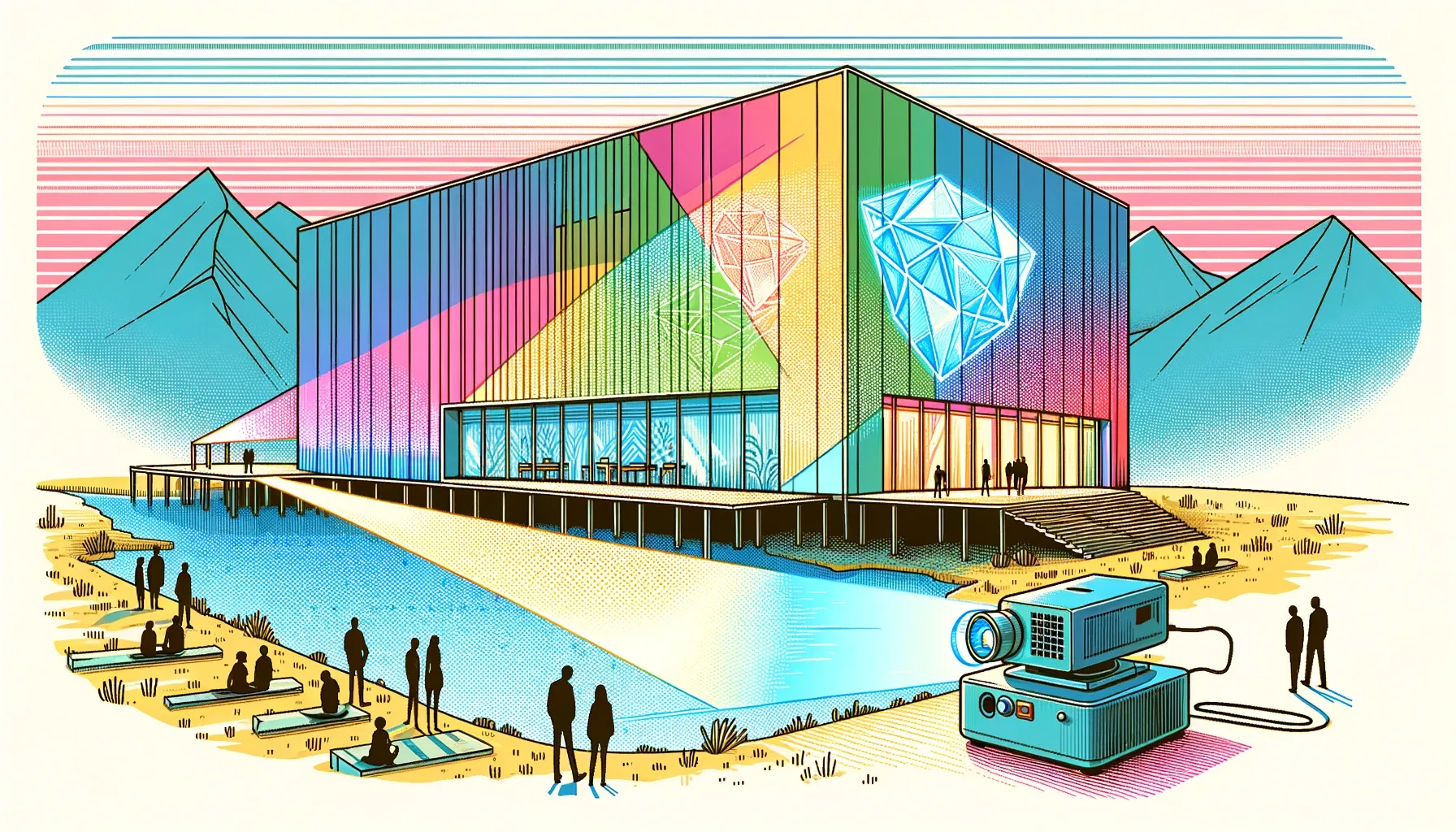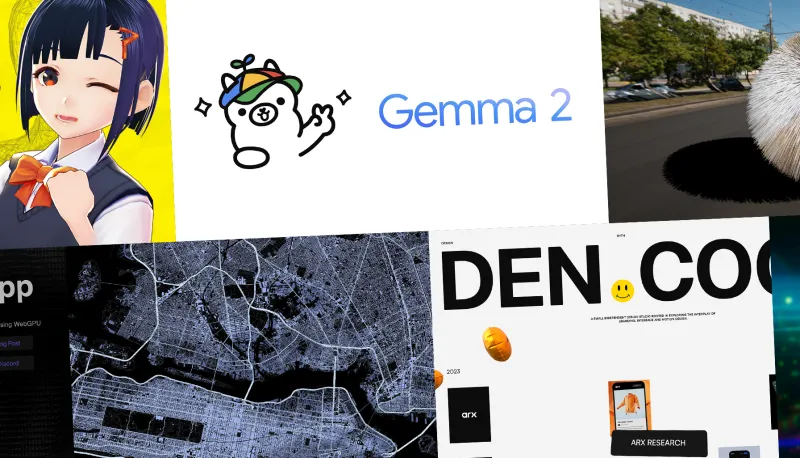Exploring the World of Projection Mapping and How WebGPU Will Transform It
The Fusion of Projection Mapping and WebGPU Unlocks Unprecedented Opportunities for Creative Branding and Engagement in 2024.
Last updated: January 13, 2024Introduction
In an era where technology seamlessly blends with creativity, two innovations notably stand out: projection mapping and WebGPU.
Projection mapping transforms ordinary objects into extraordinary visual canvases, while WebGPU introduces access to a groundbreaking phase of processing power.
This article explores the capabilities of these technologies and the exciting possibilities that emerge at their intersection.

Projection-Mapping: Painting Reality with Light
What is Projection Mapping?
Projection mapping, also known as video mapping, is a fusion of art and technology where objects, often irregularly shaped, become surfaces for video projection.
This technique transcends traditional flat-screen projections by turning various surfaces, from walls to buildings, into dynamic displays.
An example of Projection Mapping for the National Treasure Matsumoto Castle 2023-2024
The Magic Behind the Scenes
The magic of this technique lies in its ability to create mesmerizing illusions that add depth, movement, and a sense of life to otherwise static objects. It's not just about projecting images; it's about understanding the geometry of the surfaces and meticulously aligning each pixel to create seamless, vivid visuals.
This careful orchestration of light and imagery goes beyond mere projection, inviting viewers into an immersive experience that can alter perceptions of space and reality.
Whether used in advertising, entertainment, or art installations, projection mapping offers a unique way to tell stories, evoke emotions, and create unforgettable experiences. It's a powerful tool for any brand or company looking to make a lasting impression.
3D projection mapping on The Ritz-Carlton Riyadh
Projection mapping has revolutionized several sectors
Entertainment: Immersive experiences, from grand concert backdrops to theme park attractions.
Advertising: Creates memorable brand experiences, from interactive billboards to pop-up events.
Art: Artists use it to add dynamism to static objects, creating living art installations.
Education: Enhances interactive learning by projecting educational content onto physical models.
A striking example is Lyon, France's annual "Festival of Lights," where historical buildings transform into canvases for storytelling through light.
As we continue to explore its potential, the future of projection mapping holds even more exciting possibilities for bringing imagination to life.
WebGPU: A Leap Forward in Web Graphics
Introducing WebGPU
WebGPU stands for Web Graphics Processing Unit, an emerging web standard offering modern 3D graphics and computation capabilities on the web and beyond.
It promises to unlock high-performance graphics rendering and computation, empowering developers to fully harness GPU potential.
Benefits of WebGPU
Enhanced Performance
WebGPU offers significant improvements in rendering speed and efficiency, making it ideal for demanding graphics applications. This enhancement not only accelerates the rendering process but also optimizes resource utilization, allowing for smoother and more detailed visual experiences.
Cross-Platform Compatibility
WebGPU ensures uniform functionality across different platforms and devices, which is a game-changer for developers. This means that visuals created for projection mapping can be seamlessly ported to various devices, ensuring a consistent and high-quality user experience regardless of the platform.
Future-Proof
Designed to keep pace with rapidly advancing GPU technologies, WebGPU is a forward-thinking solution that anticipates future developments in graphics hardware and software. By aligning with the latest advancements, it ensures that applications built today will remain relevant and performant in the future, safeguarding investments in development.
AI Integration
WebGPU merges seamlessly with artificial intelligence (AI), paving the way for a powerful combination that will greatly enhance interactive experiences in the future.
The integration of AI with WebGPU's advanced graphics capabilities opens up new possibilities for more dynamic, intelligent, and immersive applications, setting a new benchmark for what can be achieved in interactive visual storytelling.
Enhancing Projection Mapping with WebGPU
Integrating WebGPU with projection mapping opens new frontiers. WebGPU's high-performance rendering capabilities can significantly enhance the visual complexity and interactivity of projection mapping installations.
WebGPU opens future possibilities
With WebGPU, projection mapping becomes more interactive in real-time, responding to environmental changes or audience input.
For example, a projection mapping in a room displaying a grassland could allows users to make the grass bend by touching their phone screens.
Furthermore, WebGPU's robust performance allows for the rendering of richer 3D visuals and particles, significantly stretching the limits of artistic expression. Artists and designers can now create intricate and stunning visual compositions that were previously not feasible due to hardware limitations.
WebGPU is also exceptionally powerful in enabling the display of multiple 4K feeds, a requirement that has become increasingly essential for creating crisp visuals on large surfaces. This capability ensures that high-resolution content can be rendered smoothly and efficiently, providing stunning visual clarity for large-scale installations and presentations.
At Utsubo, after a decade of creating 3D web experiences within performance constraints, WebGPU now enables us to craft amazing experiences directly, without software limitations.

Interactive Projection-Mapping: Blurring the Lines Between Virtual and Reality
Real-Time Tracking Projection Mapping or Interactive Projection Mapping is the next step in projection mapping evolution. It dynamically aligns projected images with moving objects in real-time, seamlessly merging virtual graphics with physical movements to create a living, interactive canvas.
How It Works
This technology employs sophisticated tracking systems, combining sensors, cameras, and advanced software algorithms to track movement in real-time. The projection mapping software then adjusts the images to align perfectly with the moving surfaces.
Real-Time Tracking Projection-Mapping System by Panasonic.
The Role of WebGPU
Integrating WebGPU will revolutionize Real-Time Tracking Projection Mapping further. WebGPU's computational power and efficiency enable more complex, detailed, and responsive visualizations, pushing the boundaries of real-time interactive experiences.
Performing Arts: Theatre and Dance
Imagine a modern dance performance where dancers are surrounded by a dynamic landscape that reacts to their movements. As a dancer leaps, a projection of a blooming flower follows her trajectory, creating a visual representation of growth and beauty.
Another scene could involve a digital rainstorm, where raindrops appear to splash as dancers move through the stage, blending physical and digital elements seamlessly.
A real-time body projection starring the Japanese artist Mari Katayama.
Sports and Entertainment
Envision a basketball court where the floor becomes an interactive display. As players move across the court, their stats (like points scored, assists, etc.) are projected around them in real-time. The court could also visually represent game highlights, like a trail of light following a particularly impressive shot, or changing colors to reflect team possession, enhancing both player and audience experience.
A basketball court where the floor becomes an interactive display.
Marketing and Promotion
A car showroom where each vehicle serves as a canvas for projection mapping. Prospective buyers can see different color options, internal features, and even simulated environments (like a rainy night or a sunny day) projected onto the car. This interactive display could be tailored to individual preferences, and controlled via a tablet.
Another example is an interactive storefront where passersby can change the window display through gesture or smartphone interaction, creating a dynamic, engaging advertisement that invites participation.
In each of these scenarios, the integration of WebGPU would elevate the experience. Its enhanced rendering capabilities would allow for more complex and detailed visuals, and its efficiency could enable smoother, more responsive interactions in real-time environments.
Whether it's augmenting the emotional impact of a dance, adding a new dimension to sports, or creating immersive marketing experiences, the convergence of projection mapping and WebGPU stands to redefine the boundaries of interactive visual storytelling.
In today's digital age, where social media plays a pivotal role in shaping public perception and trends, projection mapping isn't just about technological advancement; it's also a key driver for social engagement and virality.
These stunning, interactive installations are not only captivating in person but also inherently shareable online.
They often become the centerpiece of social media posts, as people love to share their experiences with visually striking and innovative content. This creates a ripple effect, where each share, like, and comment extends the reach of the experience far beyond the physical location, amplifying brand visibility and engagement.
The ability of these projection mapping events to go viral on platforms like Instagram, Twitter, and TikTok can turn them into powerful marketing tools, generating significant buzz and attracting widespread attention.
This social media aspect further enhances the value of projection mapping and WebGPU for brands, as it taps into the modern consumer's desire to engage with and share unique, memorable experiences, making it an indispensable strategy for companies seeking to leave a lasting impact in the digital world.

Conclusion
As we stand at the forefront of a technological and artistic revolution, the fusion of projection mapping and WebGPU marks an era of unparalleled creativity and innovation.
This convergence is not just a progression of technology; it's a leap into a future where the boundaries between digital and physical realities blur, giving rise to new forms of expression and storytelling.
The potential of these combined technologies is vast and largely untapped, promising to transform ordinary spaces into extraordinary experiences.
From transforming cityscapes into vibrant canvases to revolutionizing the way we interact with everyday objects, the possibilities are as limitless as our imagination.
If you are looking to explore the possibilities of fusing WebGPU with Projection Mapping, contact us to bring your next project to life.






